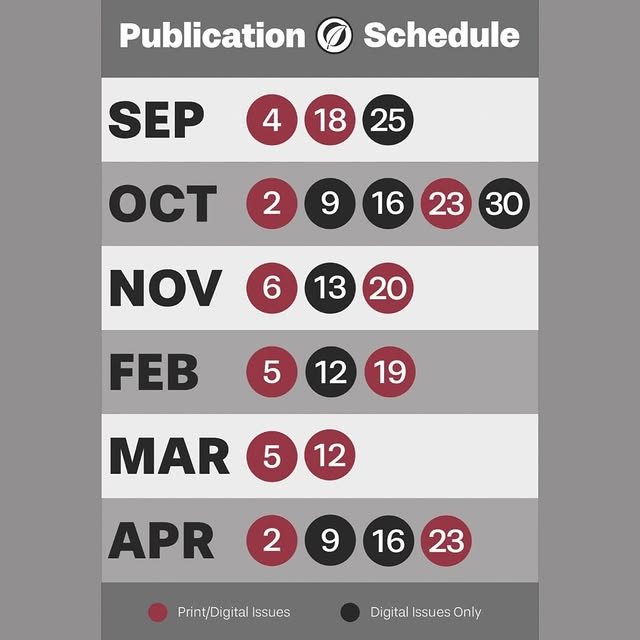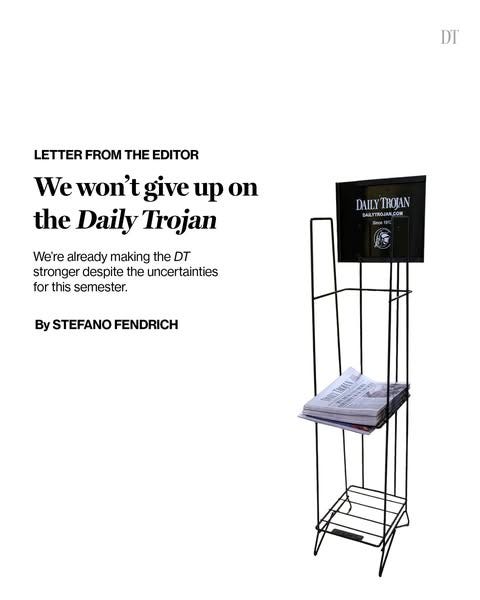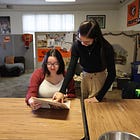Rider News, Daily Trojan navigate reduced print editions
While it’s getting harder to justify print costs, they still see its values
Is print dead?
It’s a question many college newspapers face as maintaining print editions becomes increasingly challenging in a digital-first world.
The Daily Trojan and The Rider News — one being the last West Coast student newspaper that prints daily and the other one of New Jersey’s oldest student papers — are no exception, though not by choice.
Significant budget cuts at their universities forced both publications to rethink their print strategies while preserving opportunities for students to gain hands-on experience in print journalism.
The Daily Trojan saw its budget slashed this semester to offset an $80,000 to $100,000 shortfall, reducing its print schedule from five days a week to three.
Editor-in-Chief Stefano Fendrich said the decision, made without input from student leadership, also impacted the paper’s ability to pay contributors.
The Trojan operates under the University of Southern California’s Department of Student Publications, where professional staff manage the business operations.
Despite skepticism about the future of print, Fendrich believes it remains a valuable revenue stream.
“I really do think there’s a lot of money to be made still” from selling ads through the print edition,” he said, noting that print ad revenues at the Trojan are “double or triple” those of other college newspapers.
Advertisers, Fendrich explained, are often unwilling to pay as much for digital ads as they are for print.
Still, printing three days a week instead of five saves around $30,000 annually — though it costs an estimated $20,000 in potential ad revenue, he said.
“I really don’t think we give print as much credit as it is and how valuable it really is,” he said.
Average annual advertising revenues for college newspapers peaked during the 2006-07 academic year. By 2022–2023, it fell 73%, according to the Penn State Daily Collegian Alumni Interest Group’s study.
At The Rider News at New Jersey’s Rider University, the print budget was completely cut in the fall.
Using some rainy day funds, the staff reduced print frequency and issue length, aiming to transition fully online next year.
While the staff had always prepared for a digital shift, the change was bittersweet. Executive Editor Jake Tiger recalled the moment he saw his byline in print for the first time during his first year.
“It’s like a sense of legitimacy,” he said.
Printing 12-page issues previously cost around $16,000 annually, but the reduced schedule brought that down to $13,000, Tiger said. The savings are temporary as the team works toward a streamlined digital workflow.
Print ‘brings a sense of pride’
For many student journalists, print represents more than tradition.
Managing Editor Hannah Newman said holding a physical newspaper creates a tangible sense of accomplishment.
“We work all these hours and we we love what we do,” she said. “We put a lot of time and our passion into it. And I think seeing it physically in front of us and being able to see it on a stand around campus definitely brings a sense of pride to us as journalists.”
She agreed it’s getting harder to justify the costs of print as students are more accustomed to reading news online.
Indeed. About 86% of Americans get news from digital devices while only 26% of adults reported getting news from print, the lowest recorded figure, according to Pew Research.
“I think that’s kind of where we’re at in society,” Newman said.
As much as he loves print newspapers, Tiger said he himself never subscribed to a print newspaper in his life.
“I totally get it, it’s just not where people are anymore,” he said. “It’s inevitable for pretty much every publication on Earth. Whether you’re small or as big as the New York Times, your print edition is probably going to go away at some point.”
In California, Fendrich said The Trojan doesn’t print as many copies as it did two years ago. But he said he still hears from people who appreciate it.
Digital future
For The Rider News, the digital shift involves creating platform-specific, shareable content and leveraging analytics to refine strategies.
Podcasts and other multimedia formats are part of the vision.
“Use this as a chance to get better at those skills that are becoming more important than skills associated with a print physical newspaper, since those are going away more and more by the day,” Tiger said.
For now, the paper still uploads PDF versions of its issues, allowing the graphics team to showcase their work. However, Tiger noted that most readers access individual articles online, and the PDFs may eventually be phased out.
“I could totally see a world where that is scrapped entirely,” he said. “Then they would have so much more time to do other things that are probably more effective.”
Leading the transition
The changes to both newspapers were abrupt.
The Rider News learned of the budget cut just a month before the fall semester began, while The Daily Trojan received the news shortly before the holiday break.
For newly elected leaders, the challenge was both daunting and transformative.
Tiger admitted it was stressful to envision the next phase for the publication. It was his and Newman’s first major project in their roles.
“I didn’t feel like I had the experience or the merit to be making such a huge call like this, but at the same time, I was excited about the challenge,” he said.
For Newman, it was a crash course in adaptability and leadership — the kind of professional experience few student journalists anticipate.
“Having that experience was more than we could have asked for as far as what we can bring into the next chapter of our journalism,” Newman said.
Tiger wanted to remind student journalists in similar positions that “if you’re in a leadership position at a newspaper, you’re there for a reason.”
Other students “trusted you to make these decisions if something were to come up,” he said.
💬 I want to hear from you! How did your publication handle transitioning from print to digital? Email me at nutgrafnews@gmail.com.
Story Spotlight:
📱 With TikTok’s future up in the air in the U.S., student journalists and their Gen Z peers are grappling with the potential fallout. According to Pew Research:
48% of U.S. TikTok users ages 18 to 29 said keeping up with politics is a reason they use the app
About half of users 18 to 29 said getting news is a reason they use TikTok.
🗺️ Universities are mapping where local news outlets are still thriving — and where gaps persist. Here’s how Colorado College journalism students in a class called “The Future and Sustainability of Local News” find those gaps in all 64 counties.
🎧 Editor-in-chief of Michigan’s oldest student newspaper at Hillsdale College, The Collegian, talked about what running a major college newspaper is like.
🗨️ Insights into journalism and advice for student reporters heading into 2025, from the International Center for Journalists Knight Fellows.
Featured Opportunities:
Kevin D. Liles Photography, Inc. is seeking a photography intern for the 2025 Atlanta Braves season. Apply before Jan. 31.
The Chicago Headline Club and the Investigative Project on Race and Equity are accepting applications for the 2025 FOIA Fest Boot Camp. Deadline’s Jan. 31.
Apply to the Du Bois Data Lab at Howard University this spring for HBCU students before Feb. 10.
Brookline.News in Massachusetts is hiring a part-time summer reporting intern. Apply before Feb. 14.
Submit your entries about the biggest challenge journalists face today to the SPJ/JEA high school essay contest before Feb. 19.
Sinclair has multiple internship openings around the country including Pennslyvania, Oklahoma, Rhode Island, Texas, West Virginia and Washington.
Forbes is seeking fellows for its 2025 HBCU Scholar Program. This role can be fully remote within the U.S.









